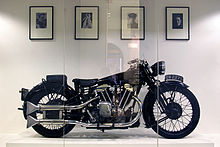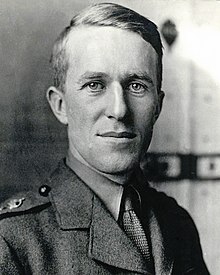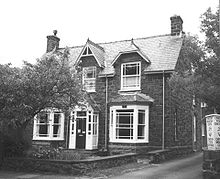TE Lawrence
Thomas Edward Lawrence , CB , DSO (born August 16, 1888 in Tremadog , Wales , † May 19, 1935 in Clouds Hill , England ), known as Lawrence of Arabia , was a British officer , archaeologist , secret agent and writer . Lawrence was best known for his participation in the British-forced uprising of the Arabs against the Ottoman Empire during the First World War .
Early years
TE Lawrence was born at Gorphwysfa house in Tremadoc, Caernarfonshire (now Gwynedd ), North Wales. His Anglo-Irish father was Sir Thomas Robert Tighe Chapman (1846-1919). Sarah Junner (1861-1959), Lawrence's mother, came from Sunderland County Durham and is considered the illegitimate daughter of John Lawrence, which is why she called herself Miss Lawrence . Sarah Junner joined the Chapmans' household as the nanny of Chapman's wife Edith in the late 1870s. Thomas Edward's parents remained unmarried and had five sons together; he was the second oldest, his youngest brother was the future archaeologist Arnold Walter Lawrence .
As early as 1909, at the age of 21, as a student of history at Oxford University , Lawrence traveled for weeks alone through Syria and Palestine to explore the architecture of crusader castles . From 1911 to 1914 he was involved in excavations in Karkemish on the upper Euphrates and learned the Arabic language . He first met the established archaeologist and country expert Gertrude Bell , whom he later met again in the secret service. In the north of Syria, he developed an enthusiastic love for the Bedouins , what he felt was a great nation. In January 1914, he joined a cartographic and archaeological expedition through the Negev desert led by the Palestine Exploration Fund , which also served the strategic exploration by the British secret service .
First World War and Arab Revolt

After the beginning of the First World War and the entry of the Ottoman Empire into the war , Lawrence was a member of the British intelligence service in Cairo from December 1914 . In June 1916, Sherif Hussein , the Emir of Mecca , and his sons sparked an uprising on the Arabian Peninsula against the Ottoman Sultan. Sherif Hussein was supported by the British with money and military advisers .
Because of his knowledge of the place and the language, Lieutenant Lawrence was selected as a liaison and sent to the scene. He quickly advanced to become one of the key figures in the Arab struggle for independence, not least thanks to a close, mutually respectful contact with Faisal I , one of the emir's sons. Lawrence, who had no special military experience, adopted tactics from guerrilla warfare , as the poorly organized Bedouins were too weak for open field battles. Such tactics were discussed even before Lawrence's arrival, so that he cannot be considered the sole author.
The guerrilla war was limited primarily to ambushes and coups to smaller Ottoman military post and bomb attacks on the Hejaz railway , a railway line from Damascus to Medina , as well as attacks on the water supply at the Jamur . These pinprick actions weakened and demoralized the Ottoman army and led to the capture of the port city of Aqaba in July 1917 . The previous conquest of al-Wajh in January 1917, the port city halfway to Aqaba, was of decisive importance - it became the turning point in the campaign against the Ottomans under Cemal Pasha . After his arrival, Lawrence had al-Wajh converted into the main base for Faisal I. On October 1st, 1918, Damascus fell to the Arab rebels, and the same day British forces marched into the city.
After the armistice, Lawrence, mentally and physically exhausted, withdrew from his special role with the Arabs. He was plagued by feelings of guilt, having known all along that the northern Arab region would be divided into British and French zones of influence after the war in accordance with the secret Sykes-Picot Agreement of 1916.
Post-war years

For Colonel transported and with the Distinguished Service Order and the Most Honorable Order of the Bath honored returned Lawrence, the more awards and high positions refused categorically back to the UK. At the peace conference in Paris in 1919 and again in Cairo in 1921, as an advisor to Churchill, he campaigned with only moderate success for the independence efforts of his Arab friends. The following quote makes his views clear:
“The story on these pages is not the story of the Arab movement, but that of my participation in it. It is the narration of everyday life, insignificant incidents of little people. There are no lessons for the world here, no revelations to shock people. It is full of trivial things, partly because no one mistakenly mistook the remains that a man might one day make history of as history, and partly because of the pleasure I had in remembering my involvement in that revolt . We were all overwhelmed by the vastness of the land, the taste of the wind, the sunlight, and the hopes we were working for. The morning air of a future world intoxicated us. We were troubled by ideas that were impossible to express and that were nebulous but that should be fought for. We lived many lives during these confusing campaigns and never spared ourselves in the process; but when we were victorious and the new world dawned, the old men came again and took our victory to match the earlier world they knew. The youth could win, but they had not learned to keep the win; and she was pitifully weak compared to old age. We thought we had worked for a new heaven and a new world, and they kindly thanked us and made their peace. "
In 1922 he resigned from the colonial service and burned his memoirs, which he later rewritten and published in an abridged form in 1927. They did not appear in their final form until after his death. He gave away all his fortune and in 1923 - brokered by a friend in the War Department, Sir Philip Chetwode - under the false name TE Shaw in the British Air Force, where he served as a common soldier until he was retired in March 1935. Until recently, he was persecuted by the public, who disregarded his desire for anonymity.
Lawrence came off the road on May 13, 1935 with his motorcycle, where he suffered severe head injuries. He was in a coma for six days and died on May 19, 1935 at the age of 46. He was buried in the new churchyard at Moreton Church. The tombstone was chosen by his mother and older brother, Bob. The stone bears the Oxford University motto: Dominus illuminatio mea (The Lord is my light). In St. Martin's Church, Wareham , Dorset, a cenotaph with an image of Lawrence in Arabic clothing was set up by his friend Eric Kennington after his death .
Heroization
The American journalist Lowell Thomas visited various theaters of war from 1917. Lawrence obtained permission for him and the cameraman Chase to research Faisal's troops. From 1919 Thomas appeared with a full-length film about Allenby's campaign and the Arab uprising. The performance was accompanied by military bands and veil dances. Thomas presented Lawrence as "Sherif", "Prince of Mecca" and "uncrowned King of Arabia" and gave the lecture a total of 2000 times in the USA, Great Britain and Australia. In 1924 Thomas published his material under the title With Lawrence in Arabia . In 1927 the biography Lawrence and the Arabs by Robert Graves appeared , in 1934 a Lawrence book by Liddell Hart . In this way, Lawrence became a myth during his lifetime.
Shortly after the war, Lawrence had completed a comprehensive report on the Arab uprising. However, he lost the manuscript and had to rewrite the work from memory. It was finally published after further revisions in 1926 under the title The Seven Pillars of Wisdom (Eng. The Seven Pillars of Wisdom ) and became a classic of world literature. Twenty years after his death, his accusatory book was published The Mint ( Under the embossing die ), in which he processed his life as a soldier and took off a passionate commitment to peace.
The visually powerful desert epic Lawrence of Arabia by David Lean from 1962 with Peter O'Toole in the lead role, Alec Guinness as Faisal, and Anthony Quinn and Omar Sharif became a classic . The film received seven Academy Awards and was nominated for three more. The film integrates the legend "Lawrence of Arabia" into the historical context, but at the same time represents a free adaptation of both Lawrence 'report and the historical events.
Works (selection)
- Revolt in the desert (Revolt in the desert) . Olms, Hildesheim 1988, ISBN 3-487-08300-0 (repr. Of the Leipzig edition 1935).
- The Seven Pillars of Wisdom . dtv, Munich 2003, ISBN 3-423-01456-3 .
- Under the die (The mint) . List, Munich 1994, ISBN 3-471-78047-5 .
- Desert guerrilla . blauwerke, Berlin 2015, ISBN 978-3-945002-05-6 .
- with CL Woolley: The Wilderness of Zin (Archaeological Report) . Palestine Exploration Fund Annal 1914–1915, London (Lawrence's first work in book form).
- Crusader Castles . The Golden Cockerel Press, London 1936.
sexuality
TE Lawrence claims to have had no sexual experience whatsoever in private letters. He was considered asexual among friends.
literature
- Lowell Thomas: With Lawrence in Arabia. Hutchinson, London 1924.
- Robert Graves : Lawrence and the Arabs. Jonathan Cape, London 1927.
- Basil Liddell Hart : TE Lawrence. 1934.
- Richard Aldington : Lawrence of Arabia. London 1955. German: The Lawrence case . Verlag Hermann Rinn, Munich o. J.
- Desmond Stewart: Lawrence of Arabia. Magicians and adventurers. Heyne, Munich 1991, ISBN 3-453-55093-5 .
- Jeremy Wilson: Lawrence of Arabia. The biography. List, Berlin 2004, ISBN 3-548-60530-3 .
- Malcolm Brown: Lawrence of Arabia. Pictures of a legend. Nicolai-Verlag, Berlin 2005, ISBN 3-89479-248-5 ( review in the NZZ of June 1, 2006, quoted in Perlentaucher ).
- Ina Grünjes: Lawrence of Arabia. Don Quixote and Crusader? The construction of TE Lawrence as a man of the Middle Ages in modern times. Edition Trafo, Berlin 2006, ISBN 3-89626-598-9 .
- James Barr : Setting the Desert on Fire: TE Lawrence and Britain's secret war in Arabia, 1916-18. London 2006, ISBN 0-7475-7986-5 .
- Peter Thorau: Lawrence of Arabia - A man and his time. Beck, Munich 2010, ISBN 978-3-406-60627-4 .
- Desmond Stewart: Lawrence of Arabia - A Biography. Claassen, Dusseldorf 1979, ISBN 3-546-48777 X .
- Werner Koch: "Lawrence von Arabien" life and work in texts and pictures, Insel-Verlag Frankfurt a. Main 1995, ISBN 3-458-33404-1
- Dick Benson-Gyles: The boy in the mask: the hidden world of Lawrence of Arabia , Dublin: The Lilliput Press, 2016, ISBN 978-1-84351-656-9
Exhibitions
- Lawrence of Arabia - Genesis of a Myth , State Museum for Nature and Man in Oldenburg, November 21, 2010 to March 27, 2011, and Rautenstrauch-Joest-Museum in Cologne, April 30, 2011 to September 11, 2011.
Web links
- Literature by and about TE Lawrence in the catalog of the German National Library
- Works by TE Lawrence in the Gutenberg-DE project
- Newspaper article about TE Lawrence in the 20th century press kit of the ZBW - Leibniz Information Center for Economics .
Individual evidence
- ↑ Peter Thorau: Lawrence of Arabia - A man and his time. Munich 2010, p. 19.
- ↑ Jeremy Wilson: TE Lawrence: Family History , The Authorized Biography, Appendix 1.
- ^ Lawrence TE Archives on RootsWeb.
- ↑ Michael Asher : Lawrence: The Uncrowned King of Arabia. Viking, London 1998, p. 343.
- ↑ Liebe zum Führer , article from January 25, 1961 on Spiegel Online
- ↑ Lawrence, Thomas Edward , in: HW Drescher (Ed.): Lexicon of English Literature. Stuttgart 1979, p. 262 f.
- ↑ Brown, 1988, letters to EM Forster (21 Dec 1927), Robert Graves (6 Nov 1928), FL Lucas (26 March 1929).
| personal data | |
|---|---|
| SURNAME | Lawrence, TE |
| ALTERNATIVE NAMES | Lawrence, Thomas Edward; Lawrence of Arabia |
| BRIEF DESCRIPTION | British officer, archaeologist, secret agent and writer |
| DATE OF BIRTH | August 16, 1888 |
| PLACE OF BIRTH | Tremadoc , Wales |
| DATE OF DEATH | May 19, 1935 |
| Place of death | Clouds Hill , England |




